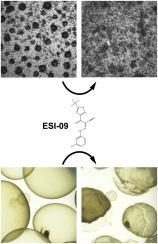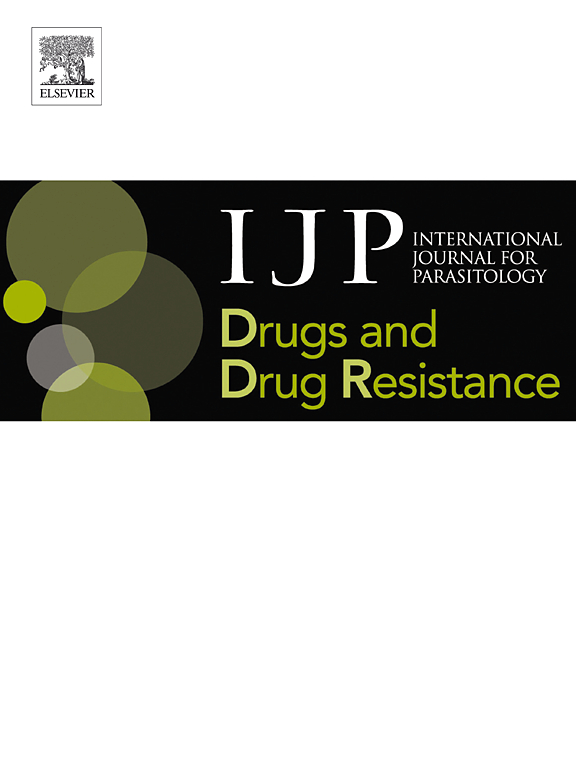对开放获取的大流行应对箱的体外筛选显示,ESI-09是一种具有抗多房棘球蚴活性的化合物
IF 3.4
2区 医学
Q1 PARASITOLOGY
International Journal for Parasitology: Drugs and Drug Resistance
Pub Date : 2025-08-23
DOI:10.1016/j.ijpddr.2025.100609
引用次数: 0
摘要
肺泡棘球蚴病(AE)是一种由狐绦虫多房棘球蚴(Echinococcus multiaris)转移期引起的危及生命的疾病,主要发生在肝脏。目前的药物治疗依赖于苯并咪唑,这种药物不杀寄生虫,需要终生治疗,而且有明显的副作用。因此,迫切需要新的药物治疗。药物再利用为识别针对被忽视疾病AE的新疗法提供了一种策略。我们报告了大流行应对箱的体外筛选,这是一个开放获取的化合物文库,由疟疾药物风险(MMV)和被忽视疾病药物行动(DNDi)组装的400种药物样分子组成,用于对抗多房肠杆菌。在10 μM的总体筛选中,使用metacestode囊泡损伤标记释放试验(基于磷酸葡萄糖异构酶的释放)和metacestode囊泡活力试验(基于ATP测量)鉴定出37种活性化合物。3个重复的重评价结果显示5个活性化合物(alexidine, carbendazim, ESI-09, MMV1581545, oxfendazole)具有抗metacestode活性。通过对生发层细胞ATP的测定,评价了这5种化合物的杀虫活性。其中一种化合物ESI-09对多房棘球蚴具有特异性作用(PGI释放实验显示其对囊泡IC50为6.06±3.18 μM,囊泡活力实验显示IC50为2.09±0.56 μM,生发层细胞IC50为2.45±0.86 μM),与哺乳动物细胞毒性相比具有较宽的治疗窗口。进一步应用海马技术和四甲基罗丹明乙酯(TMRE)实验发现ESI-09在寄生虫细胞中具有线粒体解偶联剂的作用。然而,透射电镜显示,寄生虫线粒体的超微结构没有明显的变化,尽管在被皮和层压层之间观察到细胞外囊泡样结构的分泌增加。总之,大流行应对箱的筛选确定ESI-09为治疗AE的潜在候选药物。ESI-09的体内疗效有待进一步的实验验证。本文章由计算机程序翻译,如有差异,请以英文原文为准。

In vitro screening of the open-access Pandemic Response Box reveals ESI-09 as a compound with activity against Echinococcus multilocularis
Alveolar echinococcosis (AE) is a life-threatening disease caused by the metacestode stage of the fox tapeworm Echinococcus multilocularis, primarily in the liver. Current drug treatments rely on benzimidazoles, which are not parasiticidal, requiring life-long therapy with significant side effects. Therefore, novel drug treatments are urgently needed. Drug repurposing offers a strategy to identify novel therapies against the neglected disease AE. We report on the in vitro screening of the Pandemic Response Box, an open-access compound library composed of 400 drug-like molecules assembled by Medicines for Malaria Venture (MMV) and the Drugs for Neglected Disease Initiative (DNDi), against E. multilocularis. An overview screen at 10 μM using the metacestode vesicle damage-marker release assay (based on release of phosphoglucose isomerase, PGI) and metacestode vesicle viability assay (based on ATP measurement) identified 37 active compounds. Reassessment in triplicates resulted in five active compounds (alexidine, carbendazim, ESI-09, MMV1581545, oxfendazole) displaying anti-metacestode activity. The parasiticidal activity of these five compounds was evaluated by ATP measurement in germinal layer cells. One compound, ESI-09, acted specifically against E. multilocularis (IC50 on metacestode vesicles 6.06 ± 3.18 μM by PGI release assay and 2.09 ± 0.56 μM by metacestode vesicle viability assay as well as an IC50 of 2.45 ± 0.86 μM on germinal layer cells) with a broad therapeutic window when compared to mammalian cell toxicity. Further experiments applying Seahorse technology and tetramethylrhodamine ethyl ester (TMRE) assay revealed that ESI-09 acts as a mitochondrial uncoupler in parasite cells. However, transmission electron microscopy showed no significant ultrastructural changes in parasite mitochondria, though increased secretion of extracellular vesicle-like structures between the tegument and the laminated layer was observed. In summary, screening of the Pandemic Response Box identified ESI-09 as a potential drug candidate for the treatment of AE. Further experiments are needed to evaluate the efficacy of ESI-09 in vivo.
求助全文
通过发布文献求助,成功后即可免费获取论文全文。
去求助
来源期刊

International Journal for Parasitology: Drugs and Drug Resistance
PARASITOLOGY-PHARMACOLOGY & PHARMACY
CiteScore
7.90
自引率
7.50%
发文量
31
审稿时长
48 days
期刊介绍:
The International Journal for Parasitology – Drugs and Drug Resistance is one of a series of specialist, open access journals launched by the International Journal for Parasitology. It publishes the results of original research in the area of anti-parasite drug identification, development and evaluation, and parasite drug resistance. The journal also covers research into natural products as anti-parasitic agents, and bioactive parasite products. Studies can be aimed at unicellular or multicellular parasites of human or veterinary importance.
 求助内容:
求助内容: 应助结果提醒方式:
应助结果提醒方式:


